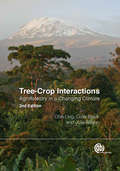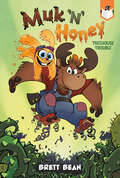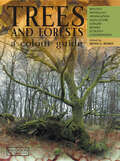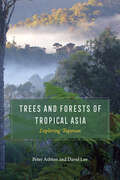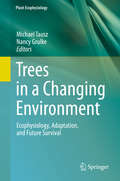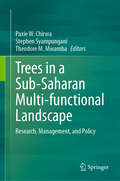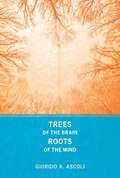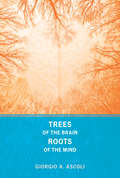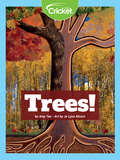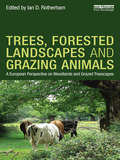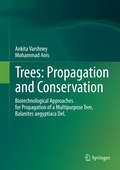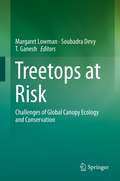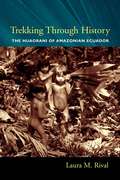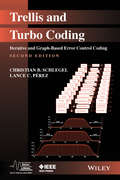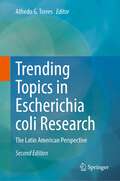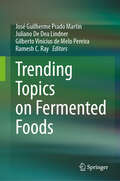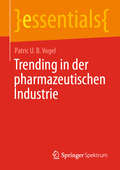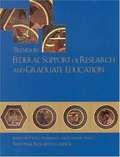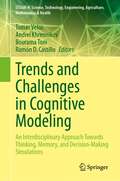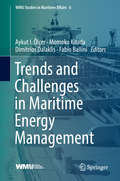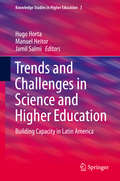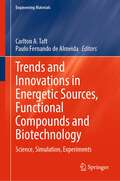- Table View
- List View
Tree-Crop Interactions: Agroforestry in a Changing Climate
by Dennis DennisThis new edition provides an update on the considerable amount of evidence on tree-crop interactions which has accumulated during the last two decades, especially on the more complex multi-strata agroforestry systems, which are typical of the humid tropics. In addition three new chapters have been added to describe the new advances in the relationship between climate change adaptation, rural development and how trees and agroforestry will contribute to a likely reduction in vulnerability to climate change in developing countries
Treehouse Trouble #1 (Muk 'n' Honey)
by Brett BeanMeet Honey Bunny and Muk Muk Moose: the inventor duo who make whimsical creations to help the forest, even if it takes them a few times to get it right! Designed to engage early readers, this chapter book series combines simple text, lively illustrations, and laugh-out-loud humor to help boost kids' confidence and create lifelong readers!Honey Bunny and Muk Muk Moose may be forest inventors, but when the staircase to their treehouse collapses, they're stumped! Not only do they have to get back up in time to take their delicious Triple Decker Hunger Wrecker concoction out of the oven, but now some of their friends need help solving their own problems, too. Can Honey Bunny and Muk Muk Moose come up with new creations to help everyone, even themselves?With full-color illustrations on every spread, this humorous and whimsical story is perfect for kids just beginning to read on their own. The short chapters, early vocabulary, and amusing illustrations make reading easy and fun! Exciting, easy-to-read books are the stepping stone a young reader needs to bridge the gap between being a beginner and being fluent.
Treekeepers: The Race for a Forested Future
by Lauren E. Oakes&“A frank, probing, but ultimately hopeful book&” (Elizabeth Kolbert) that shows how the path from climate change to a habitable future winds through the world&’s forests In recent years, planting a tree has become a catchall to represent &“doing something good for the planet.&” Many companies commit to planting a tree with every purchase. But who plants those trees and where? Will they flourish and offer the benefits that people expect? Can all the individual efforts around the world help remedy the ever-looming climate crisis? In Treekeepers, Lauren E. Oakes takes us on a poetic and practical journey from the Scottish Highlands to the Panamanian jungle to meet the scientists, innovators, and local citizens who each offer part of the answer. Their work isn&’t just about planting lots of trees, but also about understanding what it takes to grow or regrow a forest and to protect what remains. Throughout, Oakes shows the complex roles of forests in the fight against climate change, and of the people who are giving trees a chance with hope for our mutual survival. Timely, meticulously reported, and ultimately optimistic, Treekeepers teaches us how to live with a sense of urgency in our warming world, to find beauty in the present for ourselves and our children, and to take action big or small.
Trees & Forests, A Colour Guide: Biology, Pathology, Propagation, Silviculture, Surgery, Biomes, Ecology, and Conservation
by Bryan G. BowesTrees are one of the dominant features of our existence on earth and play a fundamental role in the environment. This book gives the reader an overview and understanding of trees. Subject areas covered include ecology and conservation, tree anatomy and evolution, pathology, silviculture, propagation, and surgery. The different chapters cover trees
Trees and Forests of Tropical Asia: Exploring Tapovan
by David Lee Peter AshtonInformed by decades of researching tropical Asian forests, a comprehensive, up-to-date, and beautifully illustrated synthesis of the natural history of this unique place. Trees and Forests of Tropical Asia invites readers on an expedition into the leafy, humid, forested landscapes of tropical Asia—the so-called tapovan, a Sanskrit word for the forest where knowledge is attained through tapasya, or inner struggle. Peter Ashton and David Lee, two of the world’s leading scholars on Asian tropical rain forests, reveal the geology and climate that have produced these unique forests, the diversity of species that inhabit them, the means by which rain forest tree species evolve to achieve unique ecological space, and the role of humans in modifying the landscapes over centuries. Following Peter Ashton’s extensive On the Forests of Tropical Asia, the first book to describe the forests of the entire tropical Asian region from India east to New Guinea, this new book provides a more condensed and updated overview of tropical Asian forests written accessibly for students as well as tropical forest biologists, ecologists, and conservation biologists.
Trees in a Changing Environment
by Michael Tausz Nancy GrulkeThis book delivers current state-of-the-science knowledge of tree ecophysiology, with particular emphasis on adaptation to a novel future physical and chemical environment. Unlike the focus of most books on the topic, this considers air chemistry changes (O3, NOx, and N deposition) in addition to elevated CO2 effects and its secondary effects of elevated temperature. The authors have addressed two systems essential for plant life: water handling capacity from the perspective of water transport; the coupling of xylem and phloem water potential and flow; water and nutrition uptake via likely changes in mycorrhizal relationships; control of water loss via stomata and its retention via cellular regulation; and within plant carbon dynamics from the perspective of environmental limitations to growth, allocation to defences, and changes in partitioning to respiration. The authors offer expert knowledge and insight to develop likely outcomes within the context of many unknowns. We offer this comprehensive analysis of tree responses and their capacity to respond to environmental changes to provide a better insight in understanding likelihood for survival, as well as planning for the future with long-lived, stationary organisms adapted to the past: trees.
Trees in a Sub-Saharan Multi-functional Landscape: Research, Management, and Policy
by Paxie W. Chirwa Stephen Syampungani Theodore M. MwambaAfrica is largely dependent on natural resources in its quest to achieve sustainable development goals, with its woodlands and forests known to be among the most exploited ecosystems. Anthropogenic pressure has led to the progressive conversion of these woodlands and forests into patches of regrowth stands, savanna and cropland systems. Expansion with intensification of agricultural land and the unsustainable use of fuelwood biomass are among the major drivers of such landscape transformations and the associated decline of biodiversity and ecosystem services. This phenomenon is growing in magnitude and significance with emerging environmental issues including climate change, biological invasion, and pollution arising from various land use practices, thereby jeopardizing Africa’s development pathway. Agroforestry holds promises to reverse this trend, as it provides the potential for designing multifunctional agricultural landscapes that guarantee trade-offs of food security, biodiversity conservation, and ecosystem services. Africa is characterized by highly variable ecological conditions and remarkable cultural diversity that influence the conception of landscape multifunctionality. Drawing upon the vast experience of researchers and many other professionals in Africa, this book contextualizes the roles of trees in African multifunctional landscapes, capturing the biophysical and societal diversity in the region, while scrutinizing the ongoing trend of landscape multifunctionality in Africa with reference to the global scenario. It is designed to provide a holistic and comprehensive understanding of the various roles of trees in African landscapes and shed light on the underlying functional attributes of trees, which will help readers to generate a better insight and problem-solving approach for landscape multifunctionality in the context of Africa. This book defines the multifunctional landscapes with reference to an African context. The book has fourteen chapters, covering five broad thematic areas (i) the multiple services, functions and role of trees in multifunctional landscapes; (ii) tree-based production systems, products and their contributions to rural livelihoods; (iii) drivers of land cover changes and their impacts; (iv) approaches for managing resources to integrate trees in multifunctional landscapes; and (v) external factors affecting landscape resources management in Africa.
Trees of the Brain, Roots of the Mind
by Giorgio A. AscoliThe human brain is often described as the most complex object in the universe. Tens of billions of nerve cells-tiny tree-like structures -- make up a massive network with enormous computational power. In this book, Giorgio Ascoli reveals another aspect of the human brain: the stunning beauty of its cellular form. Doing so, he makes a provocative claim about the mind-brain relationship. If each nerve cell enlarged a thousandfold looks like a tree, then a small region of the nervous system at the same magnified scale resembles a gigantic, fantastic forest. This structural majesty -- illustrated throughout the book with extraordinary color images -- hides the secrets behind the genesis of our mental states. Ascoli proposes that some of the most intriguing mysteries of the mind can be solved using the basic architectural principles of the brain. After an overview of the scientific and philosophical foundations of his argument, Ascoli links mental states with patterns of electrical activity in nerve cells, presents an emerging minority opinion of how the brain learns from experience, and unveils a radically new hypothesis of the mechanism determining what is learned, what isn't, and why. Finally, considering these notions in the context of the cosmic diversity within and among brains, Ascoli offers a new perspective on the roots of individuality and humanity.
Trees of the Brain, Roots of the Mind
by Giorgio A. AscoliAn examination of the stunning beauty of the brain's cellular form, with many color illustrations, and a provocative claim about the mind-brain relationship. The human brain is often described as the most complex object in the universe. Tens of billions of nerve cells-tiny tree-like structures—make up a massive network with enormous computational power. In this book, Giorgio Ascoli reveals another aspect of the human brain: the stunning beauty of its cellular form. Doing so, he makes a provocative claim about the mind-brain relationship. If each nerve cell enlarged a thousandfold looks like a tree, then a small region of the nervous system at the same magnified scale resembles a gigantic, fantastic forest. This structural majesty—illustrated throughout the book with extraordinary color images—hides the secrets behind the genesis of our mental states. Ascoli proposes that some of the most intriguing mysteries of the mind can be solved using the basic architectural principles of the brain. After an overview of the scientific and philosophical foundations of his argument, Ascoli links mental states with patterns of electrical activity in nerve cells, presents an emerging minority opinion of how the brain learns from experience, and unveils a radically new hypothesis of the mechanism determining what is learned, what isn't, and why. Finally, considering these notions in the context of the cosmic diversity within and among brains, Ascoli offers a new perspective on the roots of individuality and humanity.
Trees!
by Amy TaoCan you guess when trees stop growing–they don’t stop! Their massive roots keep them in the ground and require plenty of water, sunshine and nutrients from the soil to help them grow. Trees are the oldest, largest and tallest living things on Earth, with the oldest part of the tree being its strong, woody middle. Find out how a maple tree gets its start! How does a tree grow?
Trees, Forested Landscapes and Grazing Animals: A European Perspective on Woodlands and Grazed Treescapes
by Ian D. RotherhamIn this comprehensive book, the critical components of the European landscape – forest, parkland, and other grazed landscapes with trees are addressed. The book considers the history of grazed treed landscapes, of large grazing herbivores in Europe, and the implications of the past in shaping our environment today and in the future. Debates on the types of anciently grazed landscapes in Europe, and what they tell us about past and present ecology, have been especially topical and controversial recently. This treatment brings the current discussions and the latest research to a much wider audience. The book breaks new ground in broadening the scope of wood-pasture and woodland research to address sites and ecologies that have previously been overlooked but which hold potential keys to understanding landscape dynamics. Eminent contributors, including Oliver Rackham and Frans Vera, present a text which addresses the importance of history in understanding the past landscape, and the relevance of historical ecology and landscape studies in providing a future vision.
Trees: FOSS Science Stories
by University of California at Berkeley Lawrence Hall of ScienceNIMAC-sourced textbook
Trees: Propagation and Conservation
by Ankita Varshney Mohammad AnisPlant tissue culture is an essential component of Biotechnology which has gained unbeatable recognition in plant sciences for successful micropropagation and improvement of plant species, leading to the commercial application. A number of plant species have been investigated around the globe. This book presents current research on the application of in vitro technology in the improvement of Balanites aegyptiaca Del. , a medicinal plant of semi-arid tropics. The worldwide importance of forestry, summed to the lengthy generation cycles of tree species, makes unavoidable development of new technologies that complement conventional tree breeding programmes in order to obtain improved genotypes. Recently, a new set of tools has become available in the past 20 years that combined with traditional plant breeding will allow scientists to generate products that are genetically improved varieties of the future. These set of tools come under the general title of 'Biotechnology'. The three specific biotechnological tools have been successfully used in several programmes of plant conservation, namely, tissue culture techniques for in vitro propagation, the use of molecular markers to assess the degree of variability among population and techniques of long-term conservation such as encapsulation and cryopreservation. Plant tissue culture techniques are particularly relevant and become an alternative not only for large scale propagation of individuals that are threatened, reduce production costs and increase gains to the industry, but also to provide ecological advantages as in phytoremediation or in the establishment of artificial plantings in weed infested site. The book gives a complete documentation of the results and demonstration of Balanites aegyptiaca conducted by the authors over the past 5 years. The end-to-end approach developed through plant tissue culture techniques is reflected in the book and there has been a successful transfer of technology from lab to field. The authors hope that this information would provide valuable data and also be a reference material for future research activities in this area.
Treetops at Risk: Challenges of Global Canopy Ecology and Conservation
by Margaret Lowman Soubadra Devy T. GaneshForest canopies not only support high terrestrial biodiversity but also represent a critical interface between the atmosphere and the earth. They provide goods and services to support diverse human communities and offer opportunities to explore sustainable use of these resources for many generations of local livelihoods. Forest canopies are important carbon sequestration units, and in this sense, serve as climate control for the planet. Canopies are important energy production centers for the planet, and serve as the basis for many food chains. The canopy can also act as a hook for education outreach and conservation, inspiring ecotourism through recreation and other sustainable uses such as treetop walks, zip lines, and birding. Despite these critical services provided by forest canopies, almost no dedicated research in the treetops was initiated until as recently as the late 1970s when single rope techniques were developed by mountaineering professionals and adapted for use in the canopy. Subsequently, an array of canopy access tools was designed in the 1980s and early 1990s that have opened up this "eighth continent" for global exploration and discovery. This volume uses the major findings of the 5th international canopy conference as a platform for organization, but it does not mimic the sessions and presentations of the conference itself. Instead, it builds on the important themes that emerged from the conference and solicits articles that represent future priorities and advancements for canopy science in the next decade. Despite the global efforts of hundreds of forest scientists over the past 3 decades, forests are degrading at an accelerated rate and biodiversity is increasingly threatened by human activities. Given these trends - despite the very best efforts of the world's best scientists - other approaches must be taken. This volume summarizes the issue of "treetops at risk" and assembles a global authorship to examine past accomplishments and future initiatives critical in forest conservation.
Tree‑Crop Interactions: Agroforestry in a Changing Climate
by Julia Wilson Chin K Ong Dennis Dennis Colin BlackThis new edition provides an update on the considerable amount of evidence on tree-crop interactions which has accumulated during the last two decades, especially on the more complex multi-strata agroforestry systems, which are typical of the humid tropics. In addition three new chapters have been added to describe the new advances in the relationship between climate change adaptation, rural development and how trees and agroforestry will contribute to a likely reduction in vulnerability to climate change in developing countries
Trekking Through History: The Huaorani of Amazonian Ecuador (Historical Ecology Series)
by Laura RivalThe Huaorani of Ecuador lived as hunters and gatherers in the Amazonian rainforest for hundred of years, largely undisturbed by western civilization. Since their first encounter with North American missionaries in 1956, they have held a special place in journalistic and popular imagination as "Ecuador's last savages." Trekking Through History is the first description of Huaorani society and culture according to modern standards of ethnographic writing. Through her comprehensive study of their extraordinary tradition of trekking, Laura Rival shows that the Huaorani cannot be seen merely as anachronistic survivors of the Spanish Conquest. Her critical reappraisal of the notions of agricultural regression and cultural devolution challenges the universal application of the thesis that marginal tribes of the Amazon Basin represent devolved populations who have lost their knowledge of agriculture. Far from being an evolutionary event, trekking expresses cultural creativity and political agency. Through her detailed comparative discussion of native Amazonian representations of history and the environment, Rival illustrates the unique way the Huaorani have socialized nature by choosing to depend on resources created in the past—highlighting the unique contribution anthropology makes to the study of environmental history.
Trellis and Turbo Coding
by Christian B. Schlegel Lance C. PerezThis new edition has been extensively revised to reflect the progress in error control coding over the past few years. Over 60% of the material has been completely reworked, and 30% of the material is original. Convolutional, turbo, and low density parity-check (LDPC) coding and polar codes in a unified framework Advanced research-related developments such as spatial coupling A focus on algorithmic and implementation aspects of error control coding
Trending Topics in Escherichia coli Research: The Latin American Perspective
by Alfredo G. TorresThe Latin American region has been at the forefront in combating infections caused by Escherichia coli strains in humans, animals, and the environment. The continuous emergence and evolution of pathogenic E. coli strains associated with human and animal infections have demonstrated that (i) groups of related pathogenic E. coli are responsible for most infections caused by this bacterial species; (ii) diverse virulence phenotypes expressed during infection defined each one of these pathogroups; (iii) the geographical distribution of pathogroups in Latin America and the evolution of new isolates was defined by the dominant pathogroup and presence of distinct virulence strains; (iv) acquisition of mobile elements or accumulation of point mutations accelerate the development of antibiotic resistance in some of these strains. The Latin American Coalition for Escherichia coli Research (LACER), a multidisciplinary network of over seventy research groups in eleven Latin American countries and the USA, was established in 2009 to apply One Health principles in defining and combating this pathogen. The previous edition of this text, Escherichia coli in the Americas (c. 2016) was the culmination of their wisdom about E. coli, from its role as a commensal bacterium to its characteristics as a pathogen causing disease in animals and humans. This new edition presents recent advances and contextualizes all aspects of E. coli in a One Health perspective, from the environment, to animals, to humans. It addresses E. coli interactions with host microbiota, CNS, and phages. It includes cutting edge insights on hybrid strains, molecular mechanisms of virulence and pathogenesis, resistance, domestic and wild reservoirs, disease surveillance in Latin America, genomic analysis, food safety, and new therapies. Crucially, it also provides translations and analysis of key reports on Escherichia coli published in Spanish and Portuguese. This book serves as a critical resource for scientists in industry and academia, clinicians managing associated infections, and trainees and students studying basic and clinical aspects of E. coli pathogenesis.
Trending Topics on Fermented Foods
by Ramesh C. Ray José Guilherme Prado Martin Juliano De Dea Lindner Gilberto Vinícius de Melo PereiraThis book presents the trends in research on fermented foods, introducing successful cases related to the fermentation of foods in restaurants, ideas for popularizing fermented foods among the population, as well as pioneering and inspiring initiatives aimed at regulating the production and marketing of fermented foods. Fermentation has been used for thousands of years to produce a variety of foods. In the last decades, research has been increasingly devoted to the study of fermented food’s microbiome, unraveling the main aspects of the ecology of bacteria, fungi, and viruses and their impacts on product quality. Recently, research focused on the functionality of fermented foods, which has shown health benefits associated with their consumption. The science of food fermentation has evolved very quickly, mainly from the development of omic-based approaches widely used in studies around the world. Thus, despite the vast content about the microbiology of bioprocesses used in the production of fermented foods and beverages, novel insights are constantly provided by research in the area.
Trending in der pharmazeutischen Industrie (essentials)
by Patric U. VogelIn diesem Buch wird die Anwendung von Trendanalysen in pharmazeutischen Betrieben dargestellt. Trending ist ein Thema, das immer größere Bedeutung im GMP-Umfeld erlangt. Die Durchführung gängiger Trendanalyse-Methoden wird erklärt. Zudem werden die Stärken und Schwächen verschiedener Ansätze beschrieben. Anhand eines Beispiels wird dargestellt, wie Unternehmen durch Anwendung von Trending wirtschaftliche Verluste vermeiden können.
Trends In Federal Support Of Research And Graduate Education
by Committee on Trends in Federal Spending on Scientific Engineering ResearchThe Board on Science, Technology and Economic Policy updated its 1999 analysis (Appendix A, Securing America's Industrial Strength, 1999) of changes since 1990 in the distribution of federal research funding by field of science and engineering) by incorporating FY 1998 and FY 1999 obligations from the NSF Federal Funds survey, with particular attention to the trends in basic research support, changes in research fields' relative dependence on research-sponsoring agencies, and the relationship between changes in research support and changes in enrollment in graduate training in selected fields of research. The Board did not recommend funding levels for any discipline but addressed procedural aspects of R&D budgeting.
Trends and Challenges in Cognitive Modeling: An Interdisciplinary Approach Towards Thinking, Memory, and Decision-Making Simulations (STEAM-H: Science, Technology, Engineering, Agriculture, Mathematics & Health)
by Bourama Toni Andrei Khrennikov Tomas Veloz Ramón D. CastilloThis book presents interdisciplinary research in the science of Human Cognition through mathematical and computational modeling and simulation. Featuring new approaches developed by leading experts in the field of cognitive science, it highlights the relevance and depth of this important area of social sciences and its expanding reach into the biological, physical, computational and mathematical sciences. This contributed volume compiles the most recent advancements and cutting-edge applications of cognitive modeling, employing a genuinely multidisciplinary approach to simulate thinking, memory, and decision-making. The topics covered encompass a wide range of subjects, such as Agent-based Modeling in psychological research, the Nyayasutra proof pattern, the utilization of the Pheromone Trail Algorithm for modeling Analog Memory, the theory and practical applications of Social Laser Theory, addressing the challenges of probabilistic learning in brain and behavior models, adopting a Physicalistic perspective to understand the emergence of cognition and computation, an in-depth analysis of the conjunction fallacy as a factual occurrence, exploring quantum modeling and causality in physics and its extensions, examining compositional vector semantics within spiking neural networks, delving into the realms of Optimality, Prototypes, and Bilingualism, and finally, investigating the intricate dimensionality of color perception. Given its scope and approach, the book will benefit researchers and students of computational social sciences, mathematics and its applications, quantum physics.
Trends and Challenges in Maritime Energy Management (Wmu Studies In Maritime Affairs Ser. #6)
by Momoko Kitada Aykut I. Ölçer Dimitrios Dalaklis Fabio BalliniThis book provides an overview of contemporary trends and challenges in maritime energy management (MEM). Coordinated action is necessary to achieve a low carbon and energy-efficient maritime future, and MEM is the prevailing framework aimed at reducing greenhouse gas emissions resulting from maritime industry activities. The book familiarizes readers with the status quo in the field, and paves the way for finding solutions to perceived challenges. The 34 contributions cover six important aspects: regulatory framework; energy-efficient ship design; energy efficient ship and port operation; economic and social dimensions; alternative fuels and wind-assisted ship propulsion; and marine renewable energy. This pioneering work is intended for researchers and academics as well as practitioners and policymakers involved in this important field.
Trends and Challenges in Science and Higher Education
by Jamil Salmi Hugo Horta Manuel HeitorThis book discusses the role that integrated science and higher education policies may play in further democratizing and promoting social-economic development in Latin America. It suggests that such democratizing and development may be achieved in two complementary ways: i) broadening the access to knowledge through formal learning processes of higher education, and ii) promoting the advanced qualification of people while strengthening research institutions. The book shows how this entails a complex process of policy integration, with an emphasis on human resources and institutional issues combined in processes of technical change. It discusses in detail the three main challenges that most Latin American countries face in a globalized age, based on knowledge and ever-evolving learning processes. These challenges are the need to broaden the access to higher education; to make this access more socially balanced; and to recover from a long gap in investing in knowledge production and dissemination. This book treats these issues from a variety of conceptual and methodological perspectives that present a contribution to the field of science policy and higher education studies, and inform policymakers in Latin America.
Trends and Innovations in Energetic Sources, Functional Compounds and Biotechnology: Science, Simulation, Experiments (Engineering Materials)
by Carlton A. Taft Paulo Fernando de AlmeidaThis book offers a roadmap to the future, addressing pressing challenges such as energy sustainability, environmental preservation, and advancements in biotechnology and pharmaceuticals. From the exploration of novel perovskite materials for environmental NO reduction to the development of game-changing biotechnological strategies for simultaneous CO2 capture and H2S conversion, this book spans a diverse range of topics. The content dives into the realms of artificial intelligence, nanotechnology, and state-of-the-art photovoltaic solar cells. The chapters explore the potential of psychedelic substances for treating mental disorders and the use of computational tools in pesticide development. Moreover, the reader can uncover the secrets of copaiba tree oil-resin active ingredients with multifaceted medicinal properties and the application of electrical current in alcoholic fermentation. With contributions from esteemed researchers, this book offers insights into the forefront of scientific progress.
